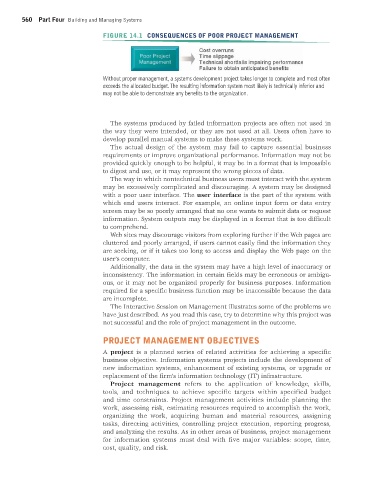Page 561 -
P. 561
560 Part Four Building and Managing Systems
FIGURE 14.1 CONSEQUENCES OF POOR PROJECT MANAGEMENT
Without proper management, a systems development project takes longer to complete and most often
exceeds the allocated budget. The resulting information system most likely is technically inferior and
may not be able to demonstrate any benefits to the organization.
The systems produced by failed information projects are often not used in
the way they were intended, or they are not used at all. Users often have to
develop parallel manual systems to make these systems work.
The actual design of the system may fail to capture essential business
requirements or improve organizational performance. Information may not be
provided quickly enough to be helpful, it may be in a format that is impossible
to digest and use, or it may represent the wrong pieces of data.
The way in which nontechnical business users must interact with the system
may be excessively complicated and discouraging. A system may be designed
with a poor user interface. The user interface is the part of the system with
which end users interact. For example, an online input form or data entry
screen may be so poorly arranged that no one wants to submit data or request
information. System outputs may be displayed in a format that is too difficult
to comprehend.
Web sites may discourage visitors from exploring further if the Web pages are
cluttered and poorly arranged, if users cannot easily find the information they
are seeking, or if it takes too long to access and display the Web page on the
user’s computer.
Additionally, the data in the system may have a high level of inaccuracy or
inconsistency. The information in certain fields may be erroneous or ambigu-
ous, or it may not be organized properly for business purposes. Information
required for a specific business function may be inaccessible because the data
are incomplete.
The Interactive Session on Management illustrates some of the problems we
have just described. As you read this case, try to determine why this project was
not successful and the role of project management in the outcome.
PROJECT MANAGEMENT OBJECTIVES
A project is a planned series of related activities for achieving a specific
business objective. Information systems projects include the development of
new information systems, enhancement of existing systems, or upgrade or
replacement of the firm’s information technology (IT) infrastructure.
Project management refers to the application of knowledge, skills,
tools, and techniques to achieve specific targets within specified budget
and time constraints. Project management activities include planning the
work, assessing risk, estimating resources required to accomplish the work,
organizing the work, acquiring human and material resources, assigning
tasks, directing activities, controlling project execution, reporting progress,
and analyzing the results. As in other areas of business, project management
for information systems must deal with five major variables: scope, time,
cost, quality, and risk.
MIS_13_Ch_14_global.indd 560 1/17/2013 2:31:57 PM

